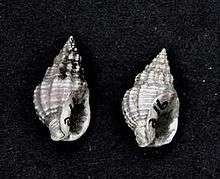Phrontis vibex
| Phrontis vibex | |
|---|---|
 | |
| Two shells of Phrontis vibex (museum specimens at Naturalis Biodiversity Center) | |
| Scientific classification | |
| Kingdom: | Animalia |
| Phylum: | Mollusca |
| Class: | Gastropoda |
| (unranked): | clade Caenogastropoda clade Hypsogastropoda clade Neogastropoda |
| Superfamily: | Buccinoidea |
| Family: | Nassariidae |
| Subfamily: | Nassariinae |
| Genus: | Phrontis |
| Species: | P. vibex |
| Binomial name | |
| Phrontis vibex (Say, 1822) | |
| Synonyms[1] [2] | |
|
synonymy
| |
Phrontis vibex, common name the bruised nassa, is a species of sea snail, a marine gastropod mollusk in the family Nassariidae, the Nassa mud snails or dog whelks.[1]
Description
The length of the shell varies from 10 mm to 20 mm. Found in deep ocean
The shell is ovate and conical. The spire is composed of six or seven indistinct whorls, subconvex, plaited throughout their whole length, crossed by fine and very close transverse striae. Those of the base are more prominent. The longitudinal folds disappear insensibly upon the right side of the body whorl, at the upper part of which we find merely nodosities. The whitish aperture is rounded.The cavity has a brown color, and is marked by transverse bands. The outer lip is bordered externally, and ornamented internally, with small, fine striae. The columella is arcuated and is covered with a pretty wide callosity, brown at its upper part, and white towards the base, which is adorned with small guttules. The coloring of the shell is olive, with a white or yellowish band. Upon the top of the body whorl, the folds and the tubercles aresometimes whitish. [3]
Distribution
Distribution of Nassarius vibex include range from 41.6°N to 27°S; 97.38°W to 34.9°W: northwest Atlantic, Gulf of Mexico, Caribbean Sea, southwest Atlantic.[1]
This marine species occurs off the following countries:
- USA: Massachusetts, New York, New Jersey, Virginia, North Carolina, South Carolina, Georgia, Florida: East Florida, West Florida; Louisiana, Texas[1]
- Mexico: Tabasco, Veracruz, Campeche State, Yucatán State, Quintana Roo[1]
- Nicaragua[1]
- Lesser Antilles[1]
- Costa Rica[1]
- Cuba[1]
- Panama[1]
- Colombia[1]
- Venezuela: Gulf of Venezuela[1]
- Jamaica[1]
- Virgin Islands: St. Croix[1]
- Brazil: Para, Maranhao, Ceara, Rio Grande do Norte, Pernambuco, Alagoas, Bahia, Rio de Janeiro, São Paulo, Parana and Santa Catarina.[1]
References
This article incorprotates CC-BY-SA-3.0 text from the reference[1]
- 1 2 3 4 5 6 7 8 9 10 11 12 13 14 15 16 Marshall, B. (2016). Phrontis vibex (Say, 1822). Accessed through: World Register of Marine Species at http://www.marinespecies.org/aphia.php?p=taxdetails&id=877061 on 2016-05-20
- ↑ Rosenberg, G. 2004. Malacolog Version 3.3.2: Western Atlantic gastropod database. The Academy of Natural Sciences, Philadelphia, PA
- ↑ Kiener (1840). General species and iconography of recent shells : comprising the Massena Museum, the collection of Lamarck, the collection of the Museum of Natural History, and the recent discoveries of travellers; Boston :W.D. Ticknor,1837 (described as Buccinum polygonatum)
- Cernohorsky W. O. (1984). Systematics of the family Nassariidae (Mollusca: Gastropoda). Bulletin of the Auckland Institute and Museum 14: 1-356.
- Rosenberg, G., F. Moretzsohn, and E. F. García. 2009. Gastropoda (Mollusca) of the Gulf of Mexico, Pp. 579–699 in Felder, D.L. and D.K. Camp (eds.), Gulf of Mexico–Origins, Waters, and Biota. Biodiversity. Texas A&M Press, College Station, Texas.
External links
- Yokoyama L. Q. & Amaral A. C. Z. (2011). "Temporal variation in egg-capsule deposition by Nassarius vibex (Gastropoda: Nassariidae) Invertebrate Reproduction & Development". Invertebrate Reproduction and Development 55(2): 82-90. Template:Doi* 10.1080/07924259.2010.548647.
- Pollock, L.W. (1998). A practical guide to the marine animals of northeastern North America. Rutgers University Press. New Brunswick, New Jersey & London. 367 pp
- Gastropods.com: Nassarius (Nassarius) vibex
| Wikimedia Commons has media related to Phrontis vibex. |